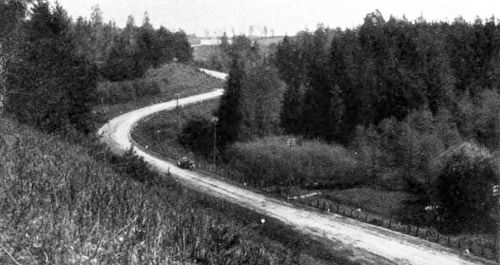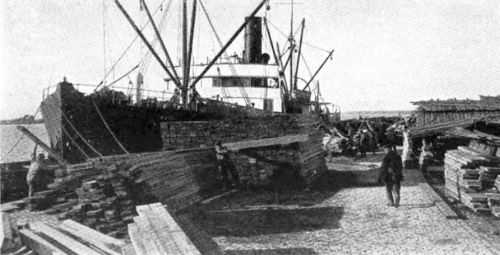LATVIAN FORESTS AND FOREST PRODUCTSCompiled by LESLIE A. MARSHALL, Editor of the Riga Times
THE forests of Latvia cover 1,726,159 hectares (over four million acres),— about 28 percent of the total area of the country. All forests are at present State property except those portions which belong to small farms.
During the first years of Latvia's independence more than half the forest area cut each year was worked by the State itself, the remainder being sold to timber merchants and forest operators. Since 1922-23, however, the State has confined its own cutting to preparing timber and fuel for the State railways and for State departments. The timber to be cut for export is now sold at auction. The cutting season, beginning Sept. 1, 1926, showed 13,493.92 hectares of forest with 290,698 standing trees sold by the end of December last, yielding a total sum of Ls. 12,470,439.80.

The cheapest way of transporting timber is by river. The principal Latvian rivers are the Daugava (on which Riga is located), the Gauja (where this picture woe taken), and the Lielupe (traversing the plain of Zemgale). These three, with their tributaries and the lesser rivers of the country, provide about 3,400 kilometers or interior waterways by which logs are transported. Timber from Russia and Poland, as well as from the Latvian forests, is floated down the Daugava to Riga.
According to species, the State forests comprise 1,006,904 hectares of coniferous trees (623,555 hectares of pine or "redwood" and 383,349 hectares of fir or "whitewood") and 279,831 hectares of coliferous trees. The latter include 153,272 hectares birch, 62,902 hect. aspen, 57,280 hect. black alder, 3,963 hect. white alder, 1,310 hect. oak, 1,011 hect. elm and 94 hectares lime.
In 1919 there were 190,000 hectares of unforested woodlands. An increasingly active reforestation policy, with the natural renewals, has reduced this unforested area to 107,234 hectares. New plantings in 1925, for example, amounted to 8,693 hectares. This policy insures the maintenance of the forests. Indeed, the area now covered by the younger and maturing growths very nearly equals that occupied by the older trees. These are being harvested according to a rational scheme extending over a period of 120 years. The annual lumber output amounts roughly to 175,000,000 cubic feet.
The inland waterways and the railways of Latvia greatly facilitate the harvesting of the State forests. The waterways are used mostly for floating sleepers, logs, pit-props and pulpwood. Sawn wood and wood for fuel from sawmills situated in the country districts are generally conveyed by rail. Owing to Latvia's geographical position, much timber from Soviet Russia, Poland and, to a certain extent, Lithuania, is exported through Latvian ports, chiefly Riga, which is one of the principal timber ports of the Baltic. On arrival of the rafts at Riga and other ports, the timber is sawn into deals, battens and boards.
The wealth of the forests and the influx of transit timber afford a wide scope for the working of sawmills in Latvia. The largest mills are located at the harbors, where the timber which has been rafted downstream is sawn. Smaller mills are built in the forests or near railway stations. Match and match-splint factories have been re-established since the War and the greater part of the available aspen wood is thus used. There are flourishing paper and cardboard mills and wood distilleries. The manufacture of plywood is increasing rapidly and a ready market is found for the entire product. These factories absorb the supply of birch and black alder. Activity is brisk in all branches of the Latvian timber industry and everything points to its continued development.
- INTRODUCTION
- Latvia's Place in the Agriculture of the World — ARTHUR B. LULE
- Effects of the War and Reconstruction on Latvian Agriculture and its Present Economic Condition — The Latvian Economist and the Geneva Economic Conference
- Agricultural Cooperatives in Latvia — PERCY MEYER
- Soil Fertility of Latvia — LOUIS E. VAN NORMAN
- Latvian Forests and Forest Products — LESLIE A. MARSHALL
- Self-Help by Mutual Help — J. NUGENT HARRIS
 Gallery
Gallery
